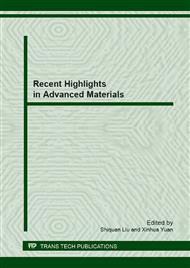[1]
T. Ohzuku, Y. Makimura, Chemistry Letters. 2001, 642-643.
Google Scholar
[2]
K. M. Shaju, G. V. S. Rao, B. V. R. Chowdari, Electrochimica Acta. 48 (2002) 145-151.
Google Scholar
[3]
Y. Koyama, I. Tanaka, H. Adachi, Y. Makimura, T. Ohzuku, Journal of Power Sources. 119 (2003) 644-648.
DOI: 10.1016/s0378-7753(03)00194-0
Google Scholar
[4]
K. Xu, Z. Jie, R. Li, Z. Chen, S. Wu, J. Gu, J. Chen, Electrochimica Acta. 60 (2012) 130-133.
Google Scholar
[5]
X. W. Li, Y. B. Lin, Y. Lin, H. Lai, Z. G. Huang, Rare Metals. 31 (2012) 140-144.
Google Scholar
[6]
T. E. Hong, E. D. Jeong, S. R. Baek, M. R. Byeon, Y. S. Lee, F. N. Khan, H. S. Yang, Journal of Applied Electrochemistry. 42 (2012) 41-46.
Google Scholar
[7]
L. Tan, H. W. Liu, Russian Journal of Electrochemistry. 47 (2011) 156-160.
Google Scholar
[8]
C. V. Rao, A. L. M. Reddy, Y. Ishikawa, P. M. Ajayan, Acs Applied Materials & Interfaces. 3 (2011) 2966-2972.
Google Scholar
[9]
J. Molenda, A. Milewska, M. Molenda, Solid State Ionics. 192 (2011) 313-320.
DOI: 10.1016/j.ssi.2010.11.026
Google Scholar
[10]
J. B. Li, Y. L. Xu, L. L. Xiong, J. P. Wang, Acta Physico-Chimica Sinica. 27 (2011) 2593-2599.
Google Scholar
[11]
Y. W. Li, Y. X. Li, S. K. Zhong, F. P. Li, J. W. Yang, Integrated Ferroelectrics. 127(2011) 150-156.
Google Scholar
[12]
M. H. Jaafar, N. S. Mohamed, R. Yahya, N. Kamarulzaman, in International Congress on Advances in Applied Physics and Materials Science. 1400 (2011) 280-285.
Google Scholar
[13]
C. X. Ding, Y. C. Bai, X. Y. Feng, C. H. Chen, Solid State Ionics. 189 (2011) 69-73.
Google Scholar
[14]
Z. -H. Wang, L. -X. Yuan, M. Wu, D. Sun, Y. -H. Huang, Electrochimica Acta. 56 (2011) 8477-8483.
Google Scholar
[15]
S. H. Park, S. S. Shin, Y. K. Sun, Materials Chemistry and Physics. 95 (2006) 218-221.
Google Scholar
[16]
L. Tan, H. W. Liu, Solid State Ionics. 181 (2010) 1530-1533.
Google Scholar
[17]
J. L. Xie, X. A. Huang, Z. B. Zhu, J. H. Dai, Ceramics International. 36 (2010) 2485-2487.
Google Scholar
[18]
Y. F. Su, F. Wu, M. Wang, L. Y. Bao, S. Chen, Journal of Power Sources. 195 (2010) 2362-2367.
Google Scholar
[19]
A. M. A. Hashem, A. E. Abdel-Ghany, A. E. Eid, J. Trottier, K. Zaghib, A. Mauger, C. M. Julien, Journal of Power Sources. 196 (2011) 8632-8637.
DOI: 10.1016/j.jpowsour.2011.06.039
Google Scholar
[20]
P. Gao, G. Yang, H. D. Liu, L. Wang, H. S. Zhou, Solid State Ionics. 207 (2012) 50-56.
Google Scholar
[21]
S. Y. Yang, X. Y. Wang, Q. Q. Chen, X. K. Yang, J. J. Li, Q. L. Wei, Journal of Solid State Electrochemistry. 16 (2012) 481-490.
Google Scholar


